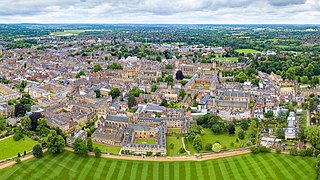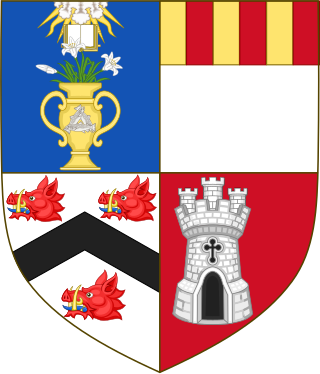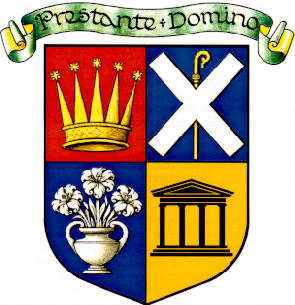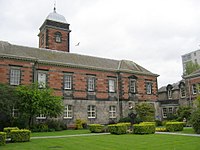The Universities (Scotland) Acts
| Universities (Scotland) Act 1853 | |
|---|---|
| Act of Parliament | |
 | |
| Citation | 16 & 17 Vict. c. 89 |
| Other legislation | |
| Repealed by | Universities (Scotland) Act 1932 |
Status: Repealed | |
| Universities (Scotland) Act 1858 | |
|---|---|
| Act of Parliament | |
 | |
| Long title | An Act to make Provision for the better Government and Discipline of the Universities of Scotland, and improving and regulating the Course of Study therein; and for the Union of the Two Universities and Colleges of Aberdeen. |
| Citation | 21 & 22 Vict. c. 83 |
| Dates | |
| Royal assent | 2 August 1858 |
Status: Amended | |
| Text of the Universities (Scotland) Act 1858 as in force today (including any amendments) within the United Kingdom, from legislation.gov.uk. | |
| Universities (Scotland) Act 1859 | |
|---|---|
| Act of Parliament | |
 | |
| Long title | An Act to remove Doubts as to Admission to the Office of Principal in the Universities of Scotland. |
| Citation | 22 & 23 Vict. c. 24 |
| Dates | |
| Royal assent | 13 August 1859 |
| Other legislation | |
| Repealed by | Universities (Scotland) Act 1932 |
Status: Repealed | |
| Universities (Scotland) Act 1889 | |
|---|---|
| Act of Parliament | |
 | |
| Long title | An Act for the better Administration and Endowment of the Universities of Scotland. |
| Citation | 52 & 53 Vict. c. 55 |
| Dates | |
| Royal assent | 30 August 1889 |
Status: Amended | |
| Text of the Universities (Scotland) Act 1889 as in force today (including any amendments) within the United Kingdom, from legislation.gov.uk. | |
| Universities (Scotland) Act 1922 | |
|---|---|
| Act of Parliament | |
 | |
| Long title | An Act to extend the powers of the Courts of the Universities of Scotland in the making of Ordinances for the superannuation and pensioning of Principals and Professors, and for the admission of Lecturers and Readers to the Senatus Academicus, and to provide for the admission of Lecturers and Readers to membership of the General Councils of those Universities. |
| Citation | 12 & 13 Geo. 5. c. 31 |
| Dates | |
| Royal assent | 20 July 1922 |
Status: Amended | |
| Text of the Universities (Scotland) Act 1922 as in force today (including any amendments) within the United Kingdom, from legislation.gov.uk. | |
| Universities (Scotland) Act 1932 | |
|---|---|
| Act of Parliament | |
 | |
| Long title | An Act to transfer to the University Courts the right of presentation or appointment to certain chairs or professorships in the faculties of divinity or theology in the universities of Scotland; to remove restrictions as regards appointment to chairs or professorships in the said universities; to extend the powers of the University Courts of the said universities with regard to the making of ordinances, and for purposes connected therewith. |
| Citation | 22 & 23 Geo. 5. c. 26 |
| Dates | |
| Royal assent | 16 June 1932 |
| Other legislation | |
| Repeals/revokes |
|
Status: Amended | |
| Text of the Universities (Scotland) Act 1932 as in force today (including any amendments) within the United Kingdom, from legislation.gov.uk. | |
| Universities (Scotland) Act 1966 | |
|---|---|
| Act of Parliament | |
 | |
| Long title | An Act to amend the law relating to the Universities of St. Andrews, Glasgow, Aberdeen and Edinburgh; to make provisions consequential on the foundation of a University of Dundee; and for purposes connected therewith. |
| Citation | 1966 c. 13 |
| Dates | |
| Royal assent | 10 March 1966 |
| Other legislation | |
| Repeals/revokes | University of St. Andrews Act 1953 |
Status: Amended | |
| Text of the Universities (Scotland) Act 1966 as in force today (including any amendments) within the United Kingdom, from legislation.gov.uk. | |
The following are the Acts of the Parliament of the United Kingdom known as the Universities (Scotland) acts. These acts of Parliament formed the basis of the modern system of governance in the ancient universities of Scotland – with the same principles being incorporated into the University of Dundee's royal charter. The acts may be cited together as the Universities (Scotland) Acts 1858 to 1966. [13] Regulation of higher education is, since 1999, a devolved matter, within the legislative competence of the Scottish Parliament.
- Text of the Universities (Scotland) Act 1858 (c. 83) as in force today (including any amendments) within the United Kingdom, from legislation.gov.uk .
- Text of the Universities (Scotland) Act 1889 (c. 55) as in force today (including any amendments) within the United Kingdom, from legislation.gov.uk .
- Text of the Universities (Scotland) Act 1922 (c. 31) as in force today (including any amendments) within the United Kingdom, from legislation.gov.uk .
- Text of the Universities (Scotland) Act 1932 (c. 26) as in force today (including any amendments) within the United Kingdom, from legislation.gov.uk .
- Text of the Universities (Scotland) Act 1966 (c. 13) as in force today (including any amendments) within the United Kingdom, from legislation.gov.uk .
Other consequences
Aside from providing a constitution for university governance, the Universities (Scotland) Acts also had a number of other consequences for higher education in Scotland. The 1858 act laid the foundations for a merger between King's College, Aberdeen and Marischal College, also in Aberdeen, [3] to form the University of Aberdeen in 1860. The 1966 act pre-empted the creation of the University of Dundee from Queen's College of the University of St Andrews. The 1889 act created a Scottish Universities Committee within the Privy Council and made provisions to allow for the expansion of the Scottish universities. The 1932 act repealed the requirement for principals and professors to declare themselves as being of the Protestant faith, formerly a requirement of the Protestant Religion and Presbyterian Church Act 1707.















